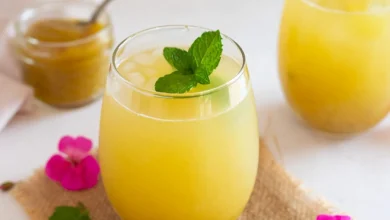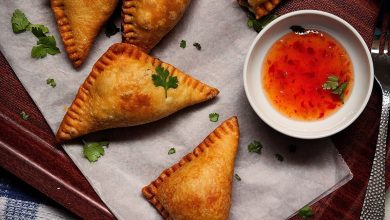Bread Halwa Recipe – A Mughlai Delight
Bread Halwa, also known as Double Ka Meetha, is an exquisite dessert with a rich history rooted in the Mughal and Nizam era. This decadent dish, which hails from Hyderabad, is traditionally made with bread, milk, sugar, and ghee, making it a perfect indulgence for festivals, special occasions, or even an elegant way to welcome unexpected guests. The luxurious blend of warm bread, sweet syrup, and fragrant cardamom, topped with golden dry fruits and edible silver foil, transforms simple bread into an unforgettable dessert.
Let’s dive into the recipe to bring this Mughlai masterpiece to your kitchen.
Ingredients for Bread Halwa
| Ingredient | Quantity |
|---|---|
| Whole Wheat Brown Bread | 10 slices |
| Sugar | 1 cup (adjustable) |
| Milk | 1 ½ cups (preferably whole milk) |
| Fresh Cream | 4 tablespoons |
| Ghee | 1 ½ tablespoons (adjustable) |
| Cardamom Powder (Elaichi) | ½ teaspoon |
| Dry Fruits (cashews, raisins, almonds, etc.) | Handful |
| Edible Silver Foil/Leaf (Chandi Ka Vark) | As needed (for garnish) |
Preparation Time: 10 minutes
Cooking Time: 20 minutes
Total Time: 30 minutes
Yield: Serves 4-6 people
Instructions for Making Bread Halwa
-
Soak the Bread:
Start by cutting the whole wheat brown bread into slices. Soak the slices in whole milk for about a minute, ensuring they absorb the milk completely. Set them aside to soften further. -
Fry the Bread:
Heat a skillet and melt 1 tablespoon of ghee (clarified butter). Add the soaked bread slices to the hot ghee and gently sauté them. Cook until the bread turns light golden brown, absorbing the flavors of the ghee and cardamom. -
Cook with Sugar and Cream:
Once the bread slices are golden, add 1 cup of sugar and 4 tablespoons of fresh cream to the skillet. Stir the mixture well, and let it cook on medium heat for approximately 10 minutes, or until the bread mixture becomes soft and mushy, with a pudding-like consistency. The sugar should dissolve completely, creating a rich syrup that binds with the bread. -
Roast the Dry Fruits:
In a separate small pan, heat the remaining ½ tablespoon of ghee and add your choice of dry fruits—typically cashews, raisins, almonds, and pistachios. Roast them until they turn a golden brown and release their nutty aroma. Set the roasted dry fruits aside for garnish. -
Assemble the Halwa:
Once the bread mixture has reached the desired consistency, remove it from the heat. Pour the mushy bread halwa into serving bowls or a large serving platter. -
Garnish and Serve:
Top the warm Bread Halwa with the roasted dry fruits and a sprinkle of cardamom powder for extra fragrance. For a touch of elegance, garnish with edible silver foil (Chandi Ka Vark) for a traditional Mughlai look. Allow the dessert to cool slightly before serving.
Serving Suggestions
Bread Halwa is best served warm or hot, making it a perfect dessert after a hearty meal. It can be enjoyed as a sweet treat during special occasions, religious festivals, or when you want to treat yourself to something truly indulgent. This dessert pairs wonderfully with a meal of Aloo Matar Sabzi, Ajwain Puri, and Boondi Raita for an authentic Mughlai-inspired spread.
Nutritional Information (Per Serving)
| Nutrient | Amount (approx.) |
|---|---|
| Calories | 250-300 kcal |
| Carbohydrates | 35-40 g |
| Protein | 4-5 g |
| Fat | 12-15 g |
| Sodium | 40-60 mg |
| Sugar | 20-25 g |
| Fiber | 2-3 g |
Tips for Making Perfect Bread Halwa
- Bread Selection: While traditional Bread Halwa is made with white bread, using whole wheat bread adds a healthy twist without compromising the flavor.
- Sugar Adjustment: You can adjust the amount of sugar according to your sweetness preference. If you prefer a less sweet version, start with ¾ cup and taste before adding more.
- Ghee: The amount of ghee used can be adjusted based on your dietary preferences. For a lighter version, you can reduce the ghee, but for the most authentic flavor, a generous amount is recommended.
- Milk Choice: Whole milk gives the best creamy texture, but you can opt for low-fat milk for a lighter version. If you’re looking for a dairy-free option, almond milk can also work, though the texture might differ slightly.
- Garnish Variations: Feel free to experiment with the dry fruits you use—pistachios, almonds, or dried figs all make excellent additions, each adding their own unique flavor.
Why You Should Try Bread Halwa
Bread Halwa isn’t just a dessert; it’s a celebration of Mughlai culinary heritage. It represents the fusion of simple ingredients into a dish that speaks of luxury, tradition, and festivity. Whether you’re planning to serve it for a special occasion or simply indulging in an afternoon treat, Bread Halwa is sure to please every palate with its aromatic sweetness and rich texture.
Bring a taste of history to your table with this delicious recipe, and enjoy the legacy of the Nizams in every bite!




